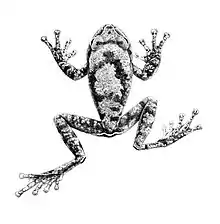Leptopelis vannutellii
Leptopelis vannutellii is a species of frog in the family Arthroleptidae. It is endemic to the highlands of southwestern Ethiopia.[1][2][3] Common names Vannutelli's tree frog and Dime forest treefrog have been coined for it.[2][4] It is named after Leonardo Vannutelli, Italian navy officer who joined Vittorio Bottego's second expedition to East Africa.[4]
| Leptopelis vannutellii | |
|---|---|
 | |
| Scientific classification | |
| Domain: | Eukaryota |
| Kingdom: | Animalia |
| Phylum: | Chordata |
| Class: | Amphibia |
| Order: | Anura |
| Family: | Arthroleptidae |
| Genus: | Leptopelis |
| Species: | L. vannutellii |
| Binomial name | |
| Leptopelis vannutellii (Boulenger, 1898) | |
| Synonyms[2] | |
|
Hylambates vannutellii Boulenger, 1898 | |
Description
Adult males measure 27–39 mm (1.1–1.5 in) and adult females 40–46 mm (1.6–1.8 in) in snout–vent length. The dorsum is grey to brown and has darker markings that sometimes are just discernible. The pattern involves a broad interorbital bar, a series of dark blotches in the shoulder region that usually form a forward-pointing triangle, and irregular blotches in the sacral region. Often both back and limbs have irregularly scattered white spots. Toes, underside of limbs, tongue, and lips are translucent blue-green.[3]
Leptopelis vannutellii is similar to Leptopelis ragazzii but can be distinguished from that species by its blue-green ventral colours and the different habitat.[3]
Habitat and conservation
Leptopelis vannutellii lives in dense, tropical deciduous forests at elevations of 1,500–2,200 m (4,900–7,200 ft) above sea level. It is an arboreal species.[1][3] The eggs are laid in nests on land, near water, and the tadpoles develop in pools and small streams, both permanent and temporary. It tolerates some habitat disturbance and is locally common at suitable sites. Habitat loss caused by forest clearance, human settlement, and agricultural encroachment is a threat to it. It occurs in the Kafa Biosphere Reserve. Chytrid fungus has been detected in this species, although its impact remains unknown.[1]
References
- IUCN SSC Amphibian Specialist Group (2013). "Leptopelis vannutellii". IUCN Red List of Threatened Species. 2013: e.T56283A16948184. doi:10.2305/IUCN.UK.2013-1.RLTS.T56283A16948184.en. Retrieved 17 November 2021.
- Frost, Darrel R. (2017). "Leptopelis vannutellii (Boulenger, 1898)". Amphibian Species of the World: an Online Reference. Version 6.0. American Museum of Natural History. Retrieved 31 August 2017.
- "Leptopelis vannutellii". AmphibiaWeb. University of California, Berkeley. 2001. Retrieved 31 August 2017.
- Beolens, Bo; Watkins, Michael; Grayson, Michael (2013). The Eponym Dictionary of Amphibians. Pelagic Publishing. p. 346. ISBN 978-1-907807-42-8.
